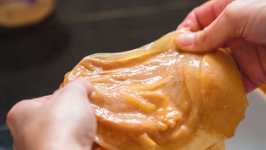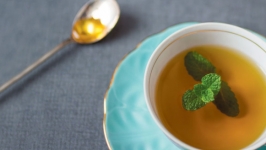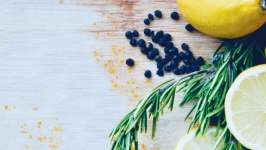Kombucha Culture
Have you noticed that kombucha (kom-BOO-cha) is everywhere—from food festivals to coffeehouses to cocktail menus to dedicated storefronts with tasting flights and growlers to go? Maybe you have your own daily habit, or have been a home brewer for years. Walk into any grocery store and you’ll find multiple brands, flavors and locally produced bottles of this fizzy beverage.
I remember my first taste of kombucha. It was 10 years ago and I was a new hire for an active travel company, leading trips based out of Berkeley, California. Fresh from corporate America, I was ready for a free-spirited adventure. A co-leader with a hippie flair that I was eager to embrace had a bottle of this weird concoction, and offered me a taste. I was not prepared for the sour flavor; however, after a few sips, I was curious. I would buy a bottle here and there (when in Rome, right?) but I soon forgot about it. Truthfully, I really didn’t love it.
Fast forward a few years and everything changed. I found myself on the coast of central California at a yoga teacher training where someone was drinking a bottle of kombucha and I was persuaded to try it again. Something was different—it tasted better. I really liked it—and not just in an “embracing my inner hippie” kind of way. Perhaps my tastes had changed, perhaps kombucha had changed. Either way, I was a convert.
WHAT IS KOMBUCHA?
At its simplest definition, kombucha is fermented tea. Traditionally made with black tea, the taste can be slightly sweet, slightly tart, with a mild vinegar tang. It’s sometimes compared to sparkling cider but with a more sour flavor. Once fermented, kombucha no longer tastes like tea. Flavors can vary widely by brand or home brew method, or by adding fruits, juices or spices after the initial fermentation.
WHERE DID IT COME FROM?
While many legends surround the story of its origin, nearly all focus on northern China, Russia, Korea or Japan. According to The Big Book of Kombucha by Hannah Crum and Alex LaGory (2016), the earliest known scientific paper about fermentation dates back to the 1850s from a German chemist. Throughout the 1900s, German and Russian research around kombucha discussed its ability to aid digestion, heal wounds and offer relief from a number of different ailments, although research seemed to end with the Cold War. During this time, kombucha was used to treat patients with various conditions, including cancer.
While it never went away, kombucha may have resurfaced in San Francisco during the counterculture movement of the 1960s, with renewed interest in the 1990s and 2000s throughout the U.S. The industry saw a temporary setback in 2010, when bottles were pulled from shelves due to concerns about alcohol levels. But with the passion and enthusiasm surrounding kombucha today, one thing is clear: This naturally carbonated beverage is here to stay.
WHY DRINK IT?
If you ask someone why they drink kombucha, you’ll often hear, “It’s good for you,” or that it makes them feel better. Others simply like the taste. Kombucha, as well as other fermented food, is a good source of probiotics and beneficial bacteria and is believed to help with nutrient absorption. Kombucha has B vitamins, vitamin C and antioxidants and is said to boost energy, help the digestive system, strengthen the immune system, reduce stress, increase metabolism, promote healthy joints and assist in detoxification. While it is love at first sip for some, for others it isn’t. If you try kombucha for the first time, be sure to take more than just one taste. You may be glad you did, as many enthusiasts sing its praises.
HOW IS KOMBUCHA MADE?
As with many fermented foods, kombucha needs a starter and a bit of a previous batch. Kombucha’s starter culture is called a SCOBY (long ‘o’), an acronym for symbiotic culture of bacteria and yeast. The SCOBY is a rubbery, gelatinous, pancake-shaped living home for the bacteria and yeast. When sweet tea and the SCOBY are fermented over a period of time, the process transforms the sugar into healthy acids and bacteria and produces a slight vinegar taste.
During its initial fermentation, kombucha brews for seven to 21 days. After the initial fermentation, the kombucha is ready for consumption. However, to create the flavors that you may have come to expect from kombucha, it typically goes through two fermentations. During this second fermentation, fruits, herbs, juices or spices can be added, and the kombucha is bottled to add carbonation. Interesting flavor combinations from local brewers in Western NY include: mango mojito, tart cherry coconut, blueberry champagne, prickly pear, chai, cranberry grape, apple spice, orange hibiscus and elderflower.
CAN KOMBUCHA BE USED FOR ANYTHING ELSE?
In addition to drinking the beverage on its own, kombucha (and the culture) can be used in cooking and cocktails, in beauty and cleaning products, or as a medical application to potentially speed healing.
DO I WANT TO TRY THIS AT HOME?
Yes! Brewing kombucha is really quite simple. The SCOBY may seem intimidating for first-time brewers—it’s what makes the magic happen. The SCOBY thickens and grows with each new batch and, when properly taken care of, can be divided and shared for years. A SCOBY can be acquired from a friend who makes kombucha or purchased from a reputable source.
Interested in trying a home brew? For more information, find a local class, check out the following resources online, find a Facebook group, get a SCOBY and go for it!
> kombuchakamp.com; kombuchabrooklyn.com; thekombuchashop.com
Local producers:
Bootleg Bucha, bootlegbucha.com
Snowy Owl Kombucha, snowyowlko.com
Barrel + Brine, barrelnbrine.com









